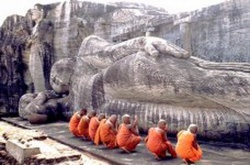Difference between revisions of "Sri Lanka"
m (1 revision: Adminos 7 october) |
|||
| Line 1: | Line 1: | ||
[[File:SriLanka.jpg|thumb|250px|]] | [[File:SriLanka.jpg|thumb|250px|]] | ||
{{WIKISeealso|Sri Lanka}} | {{WIKISeealso|Sri Lanka}} | ||
| − | Sri Lanka, formerly known as Ceylon, is a small island at the southern tip of India where approximately 70% of the people call themselves Buddhists. Buddhism was introduced into Sri Lanka in the 3rd century BCE by Mahinda, the son of King Aśoka, and has prevailed there ever since. This means that Sri Lanka has been Buddhist longer than any other country. Mahāyāna and Vajrayāna were popular at various times but Theravāda always predominated and since the 12th century has been the only form of Buddhism there. During the colonial period (16th century to 1947), Buddhists and Buddhism were often persecuted and always disadvantaged. In 1956 Buddhism became in effect the state religion. Sri Lankan monks have a long tradition of travelling widely and spreading the Dhamma as they do so. The first Buddhist monks to go to Europe in modern times were two Sri Lankans who arrived in England in 1819. | + | [[Sri Lanka]], formerly known as [[Ceylon]], is a small [[island]] at the southern tip of [[India]] where approximately 70% of the [[people]] call themselves [[Buddhists]]. [[Buddhism]] was introduced into [[Sri Lanka]] in the 3rd century BCE by [[Mahinda]], the son of [[King]] [[Aśoka]], and has prevailed there ever since. This means that [[Sri Lanka]] has been [[Buddhist]] longer than any other country. [[Mahāyāna]] and [[Vajrayāna]] were popular at various times but [[Theravāda]] always predominated and since the 12th century has been the only [[form]] of [[Buddhism]] there. During the colonial period (16th century to 1947), [[Buddhists]] and [[Buddhism]] were often persecuted and always disadvantaged. In 1956 [[Buddhism]] became in effect the [[state]] [[religion]]. [[Sri Lankan]] [[monks]] have a long [[tradition]] of travelling widely and spreading the [[Dhamma]] as they do so. The first [[Buddhist monks]] to go to {{Wiki|Europe}} in {{Wiki|modern}} times were two [[Sri Lankans]] who arrived in {{Wiki|England}} in 1819. |
| − | History of Buddhism in Ceylon, W. Rahula,1956. | + | [[History of Buddhism]] in [[Ceylon]], W. Rahula,1956. |
{{R}} | {{R}} | ||
[http://www.buddhisma2z.com/content.php?id=391 www.buddhisma2z.com] | [http://www.buddhisma2z.com/content.php?id=391 www.buddhisma2z.com] | ||
[[Category:Buddhist Terms]] | [[Category:Buddhist Terms]] | ||
[[Category:Sri Lanka]] | [[Category:Sri Lanka]] | ||
Revision as of 07:28, 16 February 2015
- See Also in Wikipedia :
Sri Lanka, formerly known as Ceylon, is a small island at the southern tip of India where approximately 70% of the people call themselves Buddhists. Buddhism was introduced into Sri Lanka in the 3rd century BCE by Mahinda, the son of King Aśoka, and has prevailed there ever since. This means that Sri Lanka has been Buddhist longer than any other country. Mahāyāna and Vajrayāna were popular at various times but Theravāda always predominated and since the 12th century has been the only form of Buddhism there. During the colonial period (16th century to 1947), Buddhists and Buddhism were often persecuted and always disadvantaged. In 1956 Buddhism became in effect the state religion. Sri Lankan monks have a long tradition of travelling widely and spreading the Dhamma as they do so. The first Buddhist monks to go to Europe in modern times were two Sri Lankans who arrived in England in 1819.
History of Buddhism in Ceylon, W. Rahula,1956.
